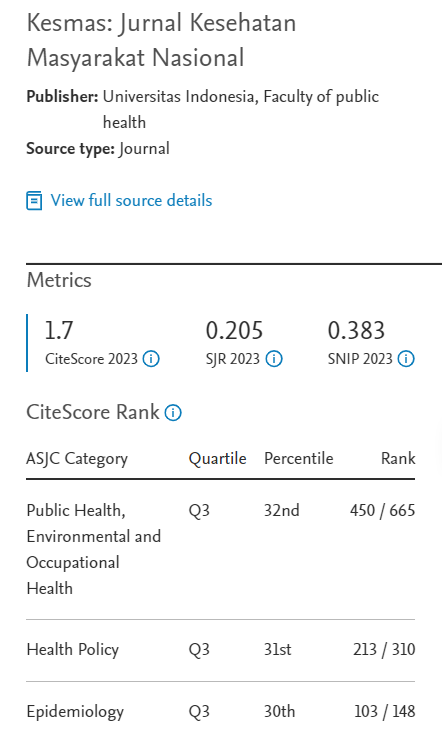Abstract
Junk food is unhealthy and poor in nutrient quality, and may result in weight gain, obesity, and coronary heart disease, if consumed regularly. The prevalence of overweight in adolescents is 5-10% higher in urban areas. Adolescents undergo lifestyle changes, including in food consumption behavior. This study aimed to determine relation between junk food consumption patterns and overweight in adolescents. This study was conducted based on a cross-sectional design. A total of 137 high school students in Jambi City were involved in this study. Patterns of junk food consumption were assessed using food frequency questionnaires that examined the eating habits of study subjects. The variables were sex, maternal education, parents’s occupation, and family’s socio-economic level. Analysis was conducted using the chi-square test and multiple logistic regression. Nutritional status was measured using body mass index-forage with WHO Antro software. The results of this study indicated a 23.4% prevalence of overweight in adolescents. After controlling for maternal education, father’s occupation, instant noodle eating habits, and tea, coffee and cookies consumption, final model showed that consumption of pizza and hamburgers among adolescents was the dominant determinant for overweight (OR=3.55). Consumption of pizza and hamburger was related to overweight among adolescents in Jambi City.
References
1. Adriani M, Wirjatmadi B. The role of nutrition in the life cycle. Jakarta: Group of Kencana Prenada Media. 2012
2. Kementerian Kesehatan Republik Indonesia. Riset kesehatan dasar 2007: laporan nasional 2007. Jakarta: Kementerian Kesehatan Republik Indonesia; 2008. p.205.
3. Kementerian Kesehatan Republik Indonesia. Riset kesehatan dasar 2010. Jakarta: Kementerian Kesehatan Republik Indonesia; 2010. p.60.
4. Kementerian Kesehatan Republik Indonesia. Riset kesehatan dasar 2013. Jakarta: Kementerian Kesehatan Republik Indonesia; 2013. p.222.
5. Sartika RAD. Faktor risiko obesitas pada anak 5-15 tahun di Indonesia. Makara Kesehatan. 2011; 15(1): 37-43.
6. Lemeshow, S, Hosmer DW, Klar J, Lwanga SK, World Health Organization. Adequacy of sample size in health studies. England: John Wiley and Sons;1997.
7. Menteri Kesehatan Republik Indonesia. Keputusan menteri kesehatan Republik Indonesia nomor: 1995/Menkes/SK/XII/2010 tentang standar antropometri penilaian status gizi anak. Jakarta: Kementerian Kesehatan Republik Indonesia; 2010. p.36-40.
8. Cuzzocrea F, Larcan R, Lanzarone C. Gender differences, personality and eating behaviors in non-clinical adolescent. Eating and Weight Disorders. 2013; 17(4): e282.
9. Newmark-Sztainer D, Story M, Perry CL, Cassey MA. Factors influencing food choices of adolescent. Journal of the American Dietetic Association. 1999; 99(8): 929-937.
10. Nurwanti E, Hadi H, Julia M. Paparan iklan junk food dan pola konsumsi junk food sebagai faktor risiko terjadinya obesitas pada anak sekolah dasar kota dan desa di Daerah Istimewa Yogyakarta. Journal of Nutrition and Dietetics Indonesia (Indonesian Journal of Nutrition and Dietetics). 2016;1(2): 59-70.
11. Story M, Neumark-Sztainer D, French S. Individual and environmental influences on adolescent eating behaviors. Journal of the American Dietetic Association. 2002; 102(3): S40-S51.
12. Badjeber F, Kapantouw, NH, Punuh M. Konsumsi fast food sebagai faktor risiko terjadinya gizi lebih pada siswa SD Negeri II Manado. Kesmas: Jurnal Kesehatan Masyarakat Universitas Sam Ratulangi. 2012; (1): 11- 14.
13. Damapolii W, Mayulu N, Masi G. Hubungan konsumsi fastfood dengan kejadian obesitas pada anak SD di Kota Manado. Jurnal Keperawatan. 2013; 1(1): 1-7.
14. Anderson B, Lyon Callo S, Fussman C, Imes G, Raffety AP. Fast food consumption and obesity among Michigan adults. Preventing Chronic Diseases. 2011; 8(4): A71.
15. Kushardianti T, Sudargo T. R. Hubungan antara keputusan memilih restoran fast food dan frekuensi konsumsi fast food terhadap status gizi anak sekolah dasar [Skripsi]. Yogyakarta: Universitas Gadjah Mada; 2014.
16. Anugrah AA, Indriasari R, Yustini. Hubungan konsumsi fast food dengan kejadian overweight pada remaja di SMA Katolik Cendrawasih Makassar [Skripsi]. Makassar: Universitas Hasanuddin; 2014.
17. Banowati L, Nugraheni N, Puhita N. Risiko konsumsi western fast food dan kebiasaan tidak makan pagi terhadap obesitas remaja studi di SMAN 1 Cirebon. Media Medika Indonesiana. 2011;45(2): 118-24.
18. Bowman SA, Gortmaker SL, Ebbeling CB, Pereira MA, Ludwig DS. Effects of fast-food consumption on energy intake and diet quality among children in a national household survey. Pediatrics. 2004; 113(1): 112-8.
19. Apriadji WH. Healthy fast food, fast food healthy dishes, favorites of children and the whole family. Jakarta: Gramedia Pustaka Utama; 2007.
20. Mahdiah. Prevalensi obesitas dan hubungan konsumsi fast food dengan kejadian obesitas pada remaja SLTP kota dan desa di Daerah Istimewa Yogyakarta. Jurnal Gizi Klinik Indonesia. 2004; 1(2): 69-77.
21. Putra RO. Junk food berkontribusi terhadap kinerja buruk dan obesitas. 2013. Available from: http://sumsel.tribunnews.com/m/index.php/ 2013/02/27/junk-foodberkontribusi-terhadap-kinerja-buruk-dan-obesitas.
22. Daradkeh G, Muhannadi A, Chandra P, Al Hajr M. Fast food vs healthy food intake and overweight/obesity prevalence among adolescents in The State of Qatar. Journal of Obesity Treatment and Weight Management. 2018; 1(1): 1-4.
Recommended Citation
Kalsum U , Nainggolan S , Ng N ,
et al.
Pizza and Hamburger Consumption to Overweight among Adolescents in Jambi City.
Kesmas.
2018;
13(2):
53-59
DOI: 10.21109/kesmas.v13i2.1694
Available at:
https://scholarhub.ui.ac.id/kesmas/vol13/iss2/1
Included in
Biostatistics Commons, Environmental Public Health Commons, Epidemiology Commons, Health Policy Commons, Health Services Research Commons, Nutrition Commons, Occupational Health and Industrial Hygiene Commons, Public Health Education and Promotion Commons, Women's Health Commons







